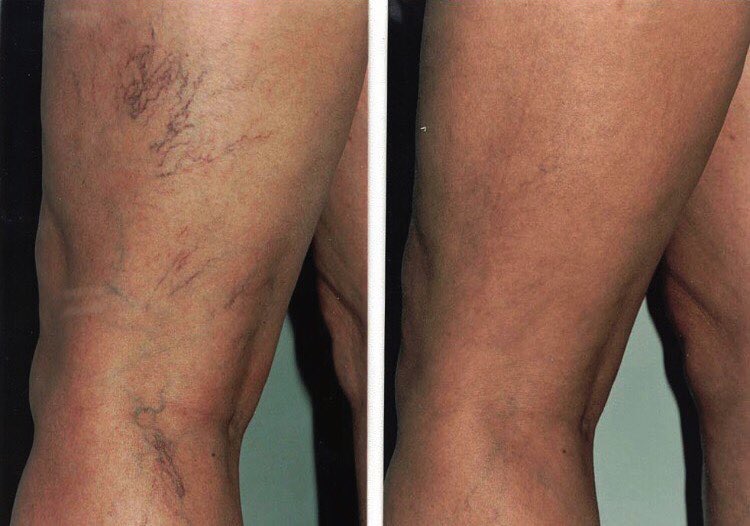Treatment involves tiny injections of an irritating chemical into the superficial veins called a sclerosant. We typically use a sclerosant called Sclerovein® that contains a small quantity of local anaesthetic to minimise discomfort. Using microsclerotherapy, we target the small feeding vessels that cause the spider veins and the treated areas typically shrink or completely disappear within the next 2-3 weeks.
We use specialised magnified polarised light to do the treatment and this improves the success rate by allowing us to visualise the vessels more accurately. A treatment session takes 30-40 minutes and typically 2-3 sessions are required to achieve a 70-80% clearance at 3-4 week intervals. We can treat quite extensive areas with microsclerotherapy and many patients are amazed how effective clearance can be despite having ‘hidden’ their legs for 10 or more years.
What are the side effects?
Expected side-effects of treatment include mild discomfort associated with the tiny injections, skin swellings that look like small insect bites (that last a few hours), mild bruising/swelling, and occasionally a small thrombosed vessel that feels like a small tube under the skin (takes 6-12 weeks to disappear). These side-effects can be improved by wearing support tights for 48 hours. About 1 in 20 patients may experience brown staining around vessels that is due to inflammation. This pigmentation typically fades after several weeks but may rarely be permanent. Rarer side-effects include a small scar at injection sites (<1% risk – the sclerosant disrupts the skin surface causing a small hole that may take 6-weeks to heal), allergy to the sclerosant chemical (<0.05% risk), and DVT (a deeper blood clot in veins – risk <0.03%). Microsclerotherapy is generally well-tolerated and the vast majority of patients tell us that complete recovery is seen within 3 weeks of treatment.
How many sessions will I need?
An appointment can be made with one of our doctors to assess your veins and advise about the procedure. Microsclerotherapy requires 2-3 sessions of treatment.
Spider leg Veins
Spider leg veins are the small blue veins that can develop on the lower legs, ankles, thighs and chest. Up to 30% women will develop spider veins in their lifetime and they are a cause of significant embarrassment to many women. Many of our patients tell us that they feel ashamed of showing their legs in public and resort to wearing long skirts or trousers. They can be seen at any age but frequently follow childbirth due to hormones that dilate blood vessels and the pressure on deeper leg veins. Spider veins are usually 1-2 mm in diameter or smaller when we call them spider capillaries. Varicose veins are larger in diameter and require either vascular surgery or foam sclerotherapy. At our clinics in Worthing, Brighton and Hove, we specialise in treatment of smaller spider veins or spider capillaries.
What causes spider leg veins?
Spider veins are due to the growth and enlargement of small superficial blood vessels in the skin. These vessels are not needed, and removal does no harm. They may occur in isolation or can develop due to deeper feeding blood vessels. Thread veins tend to be less than 1-2mm in diameter compared to varicose veins that are larger and require more aggressive treatment. If many varicose veins are present, it can be preferable to have these treated prior to the spider veins as treatment may cause the spider veins to be more prominent.
What treatments are available?
We offer a range of treatments at our clinics including microsclerotherapy, Veinwave® and laser therapy. All treatments are supervised by a medical doctor so that we can provide patients with the most optimal treatment. We will assess your veins and advise on the treatment that will be most suitable. If you are happy with the explanations provided, we can usually provide treatment on the same day or book you an appointment. Microsclerotherapy is considered the most effective treatment for spider veins that are of a reasonable size. Veinwave® and Intense Pulsed Light Laser Therapy are more suitable for small capillary vessels that are too small to be injected.

Can Lasers or Intense Pulsed Light (IPL) be used to treat leg veins?
Lasers are only effective for treating small capillary veins and mat telangiectasia. Leg veins (unlike facial veins), are significantly larger and deeper, making them less accessible to the laser light. To treat vessels, we need to heat up the blood inside the vessel and in larger vessels this process can damage surrounding skin with an increased risk of scarring in treatment leg veins. Lasers are however sometimes combined with Microsclerotherapy to remove any tiny vessels which are too small to be injected, your practitioner will discuss this with you at the time of treatment, if she feels that laser treatment would help to remove some of the smaller leg veins. Side-effects of laser treatment on the legs include redness, blistering, pigmentation and scarring. The risk of side-effects is considerably increased in darker skin types.
Varicose Veins
Varicose veins are larger thicker veins that result from leaky valves in the venous system of the leg. These large veins require either vascular surgery or advanced treatment with ‘foam sclerotherapy’. Assessment may be required with a local vascular surgeon or duplex ultrasound to assess the veins in the deeper part of the leg. We would normally refer you to a local vascular surgeon if this treatment is required.
